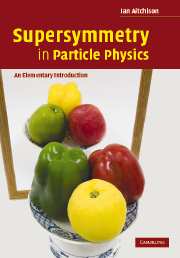Book contents
- Frontmatter
- Contents
- Preface
- Acknowledgements
- 1 Introduction and motivation
- 2 Spinors: Weyl, Dirac and Majorana
- 3 Introduction to supersymmetry and the MSSM
- 4 The supersymmetry algebra and supermultiplets
- 5 The Wess–Zumino model
- 6 Superfields
- 7 Vector (or gauge) supermultiplets
- 8 The MSSM
- 9 SUSY breaking
- 10 The Higgs sector and electroweak symmetry breaking in the MSSM
- 11 Sparticle masses in the MSSM
- 12 Some simple tree-level calculations in the MSSM
- References
- Index
12 - Some simple tree-level calculations in the MSSM
Published online by Cambridge University Press: 05 September 2012
- Frontmatter
- Contents
- Preface
- Acknowledgements
- 1 Introduction and motivation
- 2 Spinors: Weyl, Dirac and Majorana
- 3 Introduction to supersymmetry and the MSSM
- 4 The supersymmetry algebra and supermultiplets
- 5 The Wess–Zumino model
- 6 Superfields
- 7 Vector (or gauge) supermultiplets
- 8 The MSSM
- 9 SUSY breaking
- 10 The Higgs sector and electroweak symmetry breaking in the MSSM
- 11 Sparticle masses in the MSSM
- 12 Some simple tree-level calculations in the MSSM
- References
- Index
Summary
To complete our introduction to the physics of sparticles in the MSSM, we now present some calculations of sparticle decay widths and production cross sections. We work at tree-level only, with the choice of unitary gauge in the gauge sectors, where only physical fields appear (see, for example, Sections 19.5 and 19.6). We shall see how the interactions written down in Chapters 7 and 8 in rather abstract and compressed notation translate into more physical expressions, and there will be further opportunities to practise using Majorana spinors. However, since we shall only be considering a limited number of particular processes, we shall not derive general Feynman rules for Majorana particles (they can be found in, for example); instead, the matrix elements which arise will be directly evaluated by the elementary ‘reduction’ procedure, as described in Section 6.3.1 of, for example. Our results will be compared with those quoted in the book by Baer and Tata, which conveniently contains a compendium of tree-level formulae for sparticle decay widths and production cross sections. Representative calculations of cross sections for sparticle production at hadron colliders may be found in. Experimental methods for measuring superparticle masses and cross sections at the LHC are summarized in.
- Type
- Chapter
- Information
- Supersymmetry in Particle PhysicsAn Elementary Introduction, pp. 185 - 213Publisher: Cambridge University PressPrint publication year: 2007

